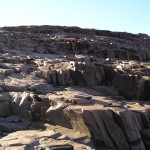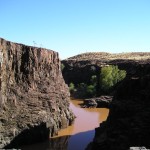Fred Jourdan, Curtin University – Mass Extinctions

Fred Jourdan
Looking back through geologic time is possible when you know what to look for.
Fred Jourdan, associate professor of applied geology at Curtin University in Australia, is studying mass extinction through the lens of ancient volcanic eruptions.
Dr. Fred Jourdan is an Associate professor at the Department of Applied Geology and the John de Laeter Centre of Mass Spectrometry at Curtin University, Perth, Australia. He is director of the Western Australian Argon Isotope Facility dedicated to research in 40Ar/39Ar geochronology. His research focuses on isotope study of timescales and processes recorded in terrestrial rocks and meteorites, with a special focus on large igneous provinces and asteroid impact events and their relationship with mass extinctions. He is also very active in the development of the 40Ar/39Ar dating technique.
Fred Jourdan – Mass Extinctions
Here is a series of pictures in the field taken by Lena Evins, co-author of the study, and showing the various outcrops of the Kalkarindji lavas. These lava flows are quite similar to the type lava that we find in Hawaii today.
- Credit: Lena Evins
- Credit: Lena Evins
- Credit: Lena Evins
- Credit: Lena Evins
In the history of life, mass extinctions are defined as a sudden demise of large number of the species, typically between 50% and up to 95% of the species present on Earth at the time of the decline.
In this study, we looked for the causes of the very first mass extinction, the so called Early-middle Cambrian extinction. It wiped out about 50% of the species five hundred and ten million years ago. These species includes the most primitive groups of Trilobites and the Archaeocyathids, reef-building, sponge looking animals.
We used radioactive dating techniques to precisely measure the age of the eruptions of the Kalkarindji volcanic province. The lava flows covered an area of more than two million square kilometres in Australia. That’s three times the size of Texas! We were we able to demonstrate that Kalkarindji volcanoes erupted at the exact same time as the Cambrian extinction. We were also able to measure a depletion of sulphur dioxide from the province’s volcanic rocks – This means that sulphur was released into the atmosphere during the eruptions.
We also calculated a near perfect chronological correlation between large volcanic province eruptions, climate shifts and mass extinctions over the history of life during the last five hundred fifty million years, with only one chance over 20 billion that this correlation is just a coincidence
We then showed the most likely process for all the mass extinctions was a rapid oscillation of the climate triggered by volcanic eruptions emitting cooling sulphur dioxide, along with warming gases like methane and carbon dioxide. These rapid oscillations of the climate made it difficult for various species to adapt, ultimately resulting in their demise






